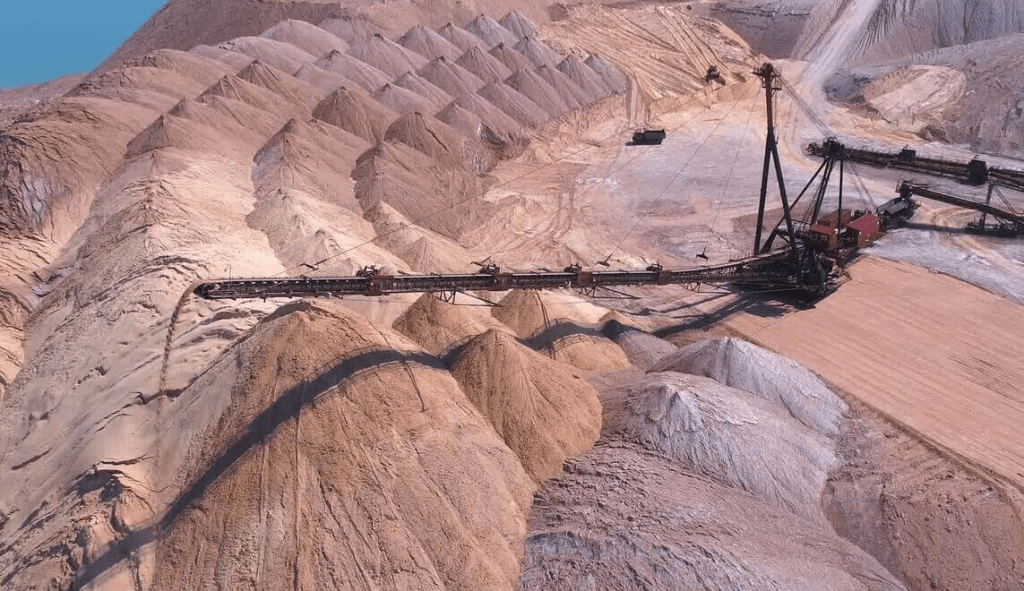- Equipment Selection Process
The process of selecting equipment for open pit mining typically involves choosing suitable shovel equipment and supporting transportation equipment first, followed by perforation equipment, and finally selecting auxiliary equipment once the primary equipment is properly matched. - Loading Equipment Selection
Excavator Selection
Selecting an excavator is a complex process that primarily considers factors such as the total amount of mining, physical and mechanical properties of rocks, mining technology, and equipment performance to maximize mining production efficiency. The production equipment in each process should be compatible with one another.
Careful consideration should be given when choosing between an electric shovel or a hydraulic shovel excavator. Electric shovels are preferred when power conditions are good, there are few types of ores, and selective mining is not required. If the bucket capacity of the excavator suitable for mining exceeds 10m³, an electric shovel should be selected; if it is less than 10m³, a hydraulic shovel should be chosen.
Front-loaded Machine Selection
When using front loaders as auxiliary equipment in open-pit mines, it is important to consider whether their primary technical performance (such as rated load capacity and traction force) meets the requirements of complex mine production. Additionally, the efficiency of loaders can be affected by the fragmented nature of operation projects. When ore blending is necessary and a stockyard near the crushing station is established for prepared ore transportation using front loaders, the size of the loader should be determined based on ore blending quantity and transportation distance.
- Transportation Equipment Selection
Transportation accounts for 40% to 60% of total costs in open-pit mining; therefore, selecting appropriate transportation equipment is crucial.
The choice of transportation equipment depends mainly on transportation methods developed for specific mines. For short distances between ores/rocks transportations single-vehicle schemes must be considered first; whereas longer distances require comprehensive technical-economic comparisons between single-vehicle transportations or joint development and transportation. The main factors influencing the choice of transportation methods are natural geological conditions, mining technical conditions, and economic factors.
When using trucks for transportation, compatibility with excavators must be considered. Generally, 2 to 4 buckets are used for a transportation distance of 1km, 3 to 5 buckets for a distance of 2km, and 3 to 5 buckets for distances ranging from 3km to 5km. A matching scheme involving trucks filled with either four or six buckets is more suitable.
- Drilling Rig Selection
Drilling rigs are often overlooked as they account for a small proportion of production costs; however, they can easily be automated and are essential open-pit mining equipment.
Roller cone drilling rigs are suitable for drilling operations in ores rocks with varying hardness levels. When designing drilling equipment for large and medium-sized mines, selecting a roller cone drill rig should be considered.
For small and medium-sized mines dealing with medium-hard ore rocks that require drilling holes in slopes or anchor holes/water drainage holes, down-the-hole drilling rigs are more suitable options.
- Selection of Auxiliary Equipment
The selection of auxiliary equipment depends on the primary production equipment. As the main equipment increases in size, the specifications of the auxiliary equipment should also be upgraded accordingly.
Crawler bulldozers are used for shoveling and transporting materials, leveling and clearing topsoil, road construction, and occasionally modifying slopes. In hard rock mines, bulldozers are utilized for 20% to 30% of the time that excavators are used. Following this principle during the design process, we select them based on the specifications of the chosen excavator and dump truck. Generally, when a dump truck has a load capacity exceeding 100t, a crawler bulldozer with a power greater than 380kW is selected.
The choice of grader grade depends on factors such as transportation road length and traffic density. For mines with long transportation roads and high traffic density, it is advisable to consider selecting graders with higher power. Typically, large mines should opt for graders with power greater than 198kW.
Wheel dozers are employed as auxiliary equipment primarily due to their excellent maneuverability and ability to perform tasks typically done by track dozers and graders. The selection can be made based on the power requirements of crawlers bulldozers and graders. Its power should exceed that of the chosen grader but remain lower than that of the selected crawler bulldozer.
Factors Affecting the Selection of Surface Coal Mine Equipment
When choosing equipment for a specific open-pit coal mine, there are various types and specifications to consider. Selecting equipment that ensures low production costs, durability, adaptability, technical performance, and high efficiency throughout the mine’s life cycle is a complex task that requires consideration of multiple factors.
(1) Resource conditions: This includes the occurrence of coal seams, structure of coal seams, thickness of overlying rock and soil layers, composition and properties of exfoliated materials.
(2) Topography, transportation conditions, climate conditions (including historical data), energy supply conditions in the mining area; regional human environment; availability of production and construction materials.
(3) Coal mine output and potential changes in stripping ratio. The selected equipment should be suitable for the scale of the mine while maximizing its utilization at each stage of coal production. It should also allow for adjustments in capacity as needed.
(4) Technical and economic factors: When selecting equipment for production purposes, it should meet general principles such as technological advancement, applicability to production needs, and economic reasonableness. Additionally:
① Good performance: The equipment should have advanced precision and technical capabilities with high production efficiency to meet operational requirements.
② Good reliability: The equipment must perform accurately and safely during use to ensure stability throughout operation.
③ Good maintainability: This refers to well-designed structures with standardized components that offer interchangeability. Easy maintenance inspections with low energy consumption and maintenance costs are important considerations.
④ Good economy: Low operating costs during the entire life cycle along with optimal overall operating efficiency are crucial aspects.
⑤ Environmental protection measures along with occupational health & safety considerations.
⑥ Technical policies promoting industry progress.

